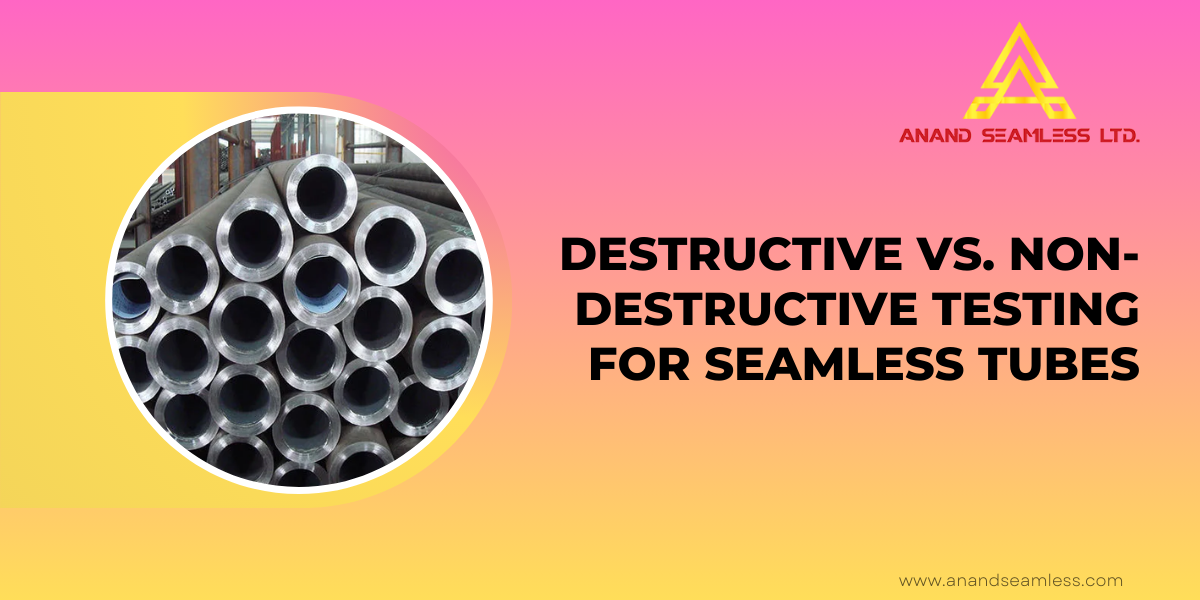Quick Inquiry
Seamless tubes play a critical role in industries such as oil and gas, power generation, automotive, and aerospace. Ensuring their quality and reliability is paramount, as these tubes often function under extreme pressures and temperatures. To maintain high standards, manufacturers and industries rely on testing methods to detect flaws and verify mechanical properties. The two primary testing methods are Destructive Testing (DT) and Non-Destructive Testing (NDT). While DT provides detailed insights into material strength and durability, NDT offers efficient, real-time defect detection without damaging the tube.
This article explores the principles, applications, advantages, and limitations of both methods, helping industries determine the most effective approach for quality assurance in seamless tubes.

What is Destructive Testing (DT) for Seamless Tubes
Destructive Testing (DT) is a material evaluation method that involves intentionally damaging or breaking a sample to assess its mechanical properties and structural integrity. The purpose of DT is to determine parameters such as tensile strength, impact resistance, hardness, and corrosion susceptibility. This method provides highly accurate data, making it essential for quality validation in critical applications.
Common Industries Relying on DT
- Oil and Gas: Verifying pipeline durability under extreme pressure and temperature fluctuations
- Aerospace: Assessing materials for high-stress resistance in aircraft components
- Automotive: Evaluating frame and structural integrity for crash safety
- Power Generation: Ensuring heat exchanger and boiler tube longevity
- Construction: Testing steel and alloy components for structural stability
Key Types of Destructive Testing
1. Tensile Testing – Measuring Strength and Elongation
Tensile testing involves applying a unidirectional force to a seamless tube sample until it breaks. The test measures yield strength, ultimate tensile strength (UTS), and elongation, helping determine the tube’s ability to withstand mechanical loads.
2. Impact Testing (Charpy & Isod Tests) – Assessing Toughness Under Sudden Force
Impact testing evaluates a material’s resistance to sudden forces and shock loads. The Charpy and Isod tests measure the amount of energy a material can absorb before fracturing, making them essential for applications requiring high-impact resistance.
3. Hardness Testing (Brinell, Rockwell, Vickers) – Determining Resistance to Deformation
Hardness testing methods, such as Brinell, Rockwell, and Vickers, assess the material’s ability to resist indentation, wear, and deformation. These tests help determine the tube’s suitability for high-pressure environments.
4. Flattening & Flanging Tests – Evaluating Ductility and Weld Integrity
- Flattening Test: The tube is compressed until deformation or cracking occurs, determining its resistance to mechanical stress.
- Flanging Test: A flange is formed on the tube’s edge to check its ductility and ability to withstand expansion.
5. Corrosion Testing – Predicting Long-Term Durability in Harsh Environments
Corrosion testing methods, such as salt spray and electrochemical tests, simulate real-world environmental exposure to predict a seamless tube’s resistance to oxidation, pitting, and stress corrosion cracking.
Advantages and Limitations of Destructive Testing
Advantages:
- High accuracy: DT provides precise data on mechanical properties
- Reliable failure prediction: Helps industries understand material weaknesses before actual deployment
- Compliance assurance: Ensures seamless tubes meet industry regulations and standards
Limitations:
- Permanent damage: Tested samples are destroyed, making them unusable
- Higher material wastage: Requires dedicated specimens, increasing production costs
- Time-consuming and costly: Extensive testing can lead to higher expenses and longer inspection cycles
What is Non-Destructive Testing (NDT) for Seamless Tubes
Non-Destructive Testing (NDT) is a set of inspection techniques used to detect internal and surface defects without damaging the material. Unlike DT, NDT ensures 100% of the product remains usable, making it ideal for high-volume production and in-service inspections. It plays a crucial role in industries requiring continuous operation and safety compliance.
Industries Where NDT is Preferred
- Oil and Gas: Inspecting pipelines and refinery components for leaks and cracks
- Aerospace: Ensuring aircraft structural integrity with real-time flaw detection
- Automotive: Checking for defects in engine components and chassis
- Power Plants: Examining boiler tubes for corrosion and wear
- Manufacturing: Validating seamless tubes before distribution
Common Non-Destructive Testing Methods
1. Ultrasonic Testing (UT) – Detecting Internal Flaws Using Sound Waves
UT utilises high-frequency sound waves to identify internal discontinuities, voids, or inclusions in seamless tubes. The technique is highly effective for detecting subsurface defects and material inconsistencies.
2. Eddy Current Testing (ECT) – Identifying Surface and Subsurface Defects
ECT applies electromagnetic induction to reveal surface cracks, thickness variations, and material inconsistencies. It is widely used for rapid inline inspections in seamless tube manufacturing.
3. Magnetic Particle Inspection (MPI) – Spotting Cracks in Ferromagnetic Materials
MPI detects surface and near-surface discontinuities by applying a magnetic field and iron particles to ferromagnetic materials. The particles cluster around defects, making them visible under special lighting.
4. Dye Penetrant Testing (DPT) – Highlighting Surface Discontinuities
DPT involves applying a liquid dye to the surface of seamless tubes. The dye seeps into cracks and is later revealed under ultraviolet light, identifying surface-level defects with high precision.
5. Radiographic Testing (X-ray & Gamma Ray) – Capturing Internal Defects via Imaging
Radiographic testing employs X-ray or gamma-ray imaging to examine the internal structure of seamless tubes, allowing inspectors to identify cracks, voids, and welding defects without disassembling components.
Advantages and Limitations of Non-Destructive Testing
Advantages:
- Ensures 100% product usability: No material is wasted, making it cost-effective
- Quick and scalable: Suitable for mass production and real-time inspections
- Non-invasive defect detection: Ideal for operational and in-service evaluations
Limitations:
- Requires skilled technicians: Proper interpretation demands extensive training and expertise
- Higher equipment costs: Advanced NDT machines involve significant initial investment
- Limited depth penetration in some methods: Certain techniques, like DPT, are restricted to surface defect detection
Learn More About Our Process!
Comparing DT and NDT for Seamless Tubes
Material Destruction vs. Preservation
The fundamental distinction between Destructive Testing (DT) and Non-Destructive Testing (NDT) lies in their impact on the material. DT involves physically damaging the seamless tube to assess its mechanical properties, such as tensile strength, hardness, and impact resistance. This method provides highly detailed insights but results in the tested sample becoming unusable.
On the other hand, NDT methods, such as ultrasonic, radiographic, and eddy current testing, allow for material evaluation without causing any damage. These techniques are ideal for testing entire batches of seamless tubes without compromising their usability.
Accuracy Levels and Data Reliability
While DT provides precise, quantifiable results regarding a material’s structural integrity, it is limited by sample size. Only a few specimens from a production batch undergo testing, which may not fully represent the overall quality of the entire batch.
In contrast, NDT offers broader coverage by allowing multiple or even all seamless tubes in a batch to be examined. Techniques like phased array ultrasonic testing (PAUT) and magnetic particle inspection (MPI) can detect minute defects within tubes that might not be visible through destructive analysis. However, NDT may sometimes require supplementary DT verification to confirm results.
Cost, Efficiency, and Applicability
DT is often more expensive due to material wastage and longer testing durations, as it requires sample extraction, preparation, and physical testing. This method is typically used in critical applications where precise mechanical properties must be validated before large-scale manufacturing begins.
In contrast, NDT methods are cost-effective and time-efficient, as they allow for continuous inspection without halting production. Techniques like ultrasonic and radiographic testing enable rapid defect detection, minimising downtime and reducing overall quality control costs.
Suitability for Different Seamless Tube Applications
Industries like oil & gas, power generation, and aerospace rely on seamless tubes for high-pressure and high-temperature applications. DT is often employed during the initial qualification phase of materials for these industries. However, NDT is preferred for routine inspections, ensuring defect-free tubes reach end-use applications.
Compliance with Industry Standards
Seamless tubes must meet strict quality regulations set by international bodies like ASME, ASTM, and ISO. Standards such as ASTM A213 for boiler tubes and ASME SA179 for heat exchanger tubes mandate specific testing procedures, often requiring a combination of both DT and NDT for comprehensive evaluation.
Read More: Costly Effects of Poor-Quality Heat Exchanger Tubes
Regulatory Testing Mandates for Seamless Tubes
Certain applications, such as nuclear power plants and offshore drilling, require rigorous compliance with regulatory standards. NDT methods like radiographic testing (RT) and liquid penetrant testing (LPT) are essential for detecting hidden flaws, while DT methods like impact testing ensure that tubes can withstand extreme operational conditions.
Which Testing Method Ensures Superior Quality?
Balancing Destructive and Non-Destructive Testing for Optimal Quality Assurance
A combination of DT and NDT often provides the most reliable quality assessment for seamless tubes. While DT is critical for material characterisation and compliance verification, NDT ensures real-time defect detection and continuous quality monitoring. Manufacturers and end-users must balance both methods based on application requirements, cost constraints, and regulatory compliance.
Ensure the Highest Quality Seamless Tubes with Expert Testing Solutions
At Anand Seamless Limited, a leading seamless tube manufacturer in India, we specialise in producing high-performance tubes that meet the highest industry standards. As a trusted manufacturer, we utilise advanced Destructive Testing (DT) and Non-Destructive Testing (NDT) to ensure exceptional durability, strength, and defect-free performance.
With full compliance with ASME, ASTM, and ISO regulations, our precision-engineered seamless tubes are ideal for industries such as oil & gas, power plants, and aerospace. Our rigorous quality control processes, backed by state-of-the-art testing technologies, ensure maximum reliability and safety in critical applications.
Partner with a reliable seamless tube manufacturer for superior-quality seamless tubes that deliver unmatched performance and longevity. Contact us today at +91-9099996853 to discuss your requirements and discover the perfect solution tailored to your industry needs!
lATEST BLOG |
|
U-Tube vs. Straight-Tube Heat Exchangers: Comparison Guide
Heat exchangers play a crucial role in industries |
|
Destructive vs. Non-Destructive Testing for Seamless Tubes
Seamless tubes play a critical role in industries |
|
The Hidden Costs of Poor-Quality Heat Exchanger Tubes: A Manufacturer’s Perspective
Heat exchangers play a critical role in various in |
|
Seamless Tubes in Boiler and Power Plants: Why They Are a Game-Changer
Seamless tubes are crucial in various industrial a |
|
Comparing Circular vs. Rectangular Finned Tubes: Which One Works Best?
In heat transfer applications, finned tube heat ex |

